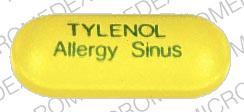Tylenol Allergy Sinus Interactions
There are 623 drugs known to interact with Tylenol Allergy Sinus (acetaminophen / chlorpheniramine / pseudoephedrine), along with 13 disease interactions, and 1 alcohol/food interaction. Of the total drug interactions, 40 are major, 563 are moderate, and 20 are minor.
- View all 623 medications that may interact with Tylenol Allergy Sinus
- View Tylenol Allergy Sinus alcohol/food interactions (1)
- View Tylenol Allergy Sinus disease interactions (13)
Most frequently checked interactions
View interaction reports for Tylenol Allergy Sinus (acetaminophen / chlorpheniramine / pseudoephedrine) and the medicines listed below.
- acetaminophen
- Advil (ibuprofen)
- albuterol
- alprazolam
- Ambien (zolpidem)
- amiodarone
- amitriptyline
- atenolol
- atorvastatin
- azithromycin
- Benadryl (diphenhydramine)
- Benadryl Allergy (diphenhydramine)
- biotin
- Claritin (loratadine)
- clonazepam
- Cymbalta (duloxetine)
- duloxetine
- Fish Oil (omega-3 polyunsaturated fatty acids)
- gabapentin
- ibuprofen
- levothyroxine
- lisinopril
- Lyrica (pregabalin)
- metformin
- omeprazole
- Symbicort (budesonide / formoterol)
- trazodone
- Tylenol (acetaminophen)
- Vitamin B12 (cyanocobalamin)
- Zyrtec (cetirizine)
Tylenol Allergy Sinus alcohol/food interactions
There is 1 alcohol/food interaction with Tylenol Allergy Sinus (acetaminophen / chlorpheniramine / pseudoephedrine).
Tylenol Allergy Sinus disease interactions
There are 13 disease interactions with Tylenol Allergy Sinus (acetaminophen / chlorpheniramine / pseudoephedrine) which include:
- alcoholism
- liver disease
- cardiovascular disease
- PKU
- anticholinergic effects
- asthma/COPD
- cardiovascular
- renal/liver disease
- GI narrowing
- PKU
- BPH
- diabetes
- glaucoma
More about Tylenol Allergy Sinus (acetaminophen / chlorpheniramine / pseudoephedrine)
- Compare alternatives
- Drug images
- Side effects
- Dosage information
- Drug class: upper respiratory combinations
Related treatment guides
Drug Interaction Classification
| Highly clinically significant. Avoid combinations; the risk of the interaction outweighs the benefit. | |
| Moderately clinically significant. Usually avoid combinations; use it only under special circumstances. | |
| Minimally clinically significant. Minimize risk; assess risk and consider an alternative drug, take steps to circumvent the interaction risk and/or institute a monitoring plan. | |
| No interaction information available. |
See also:
Further information
Always consult your healthcare provider to ensure the information displayed on this page applies to your personal circumstances.


